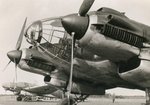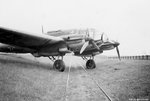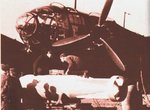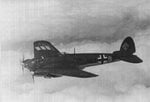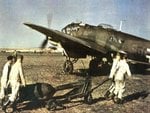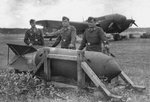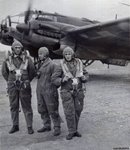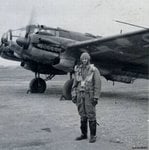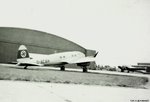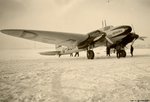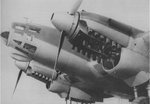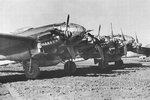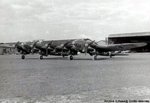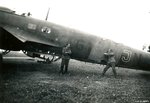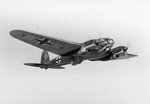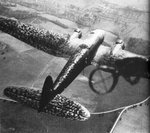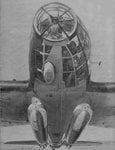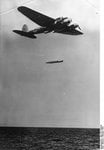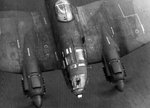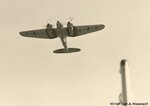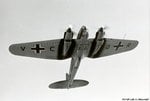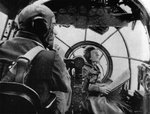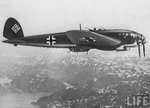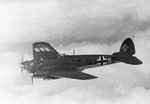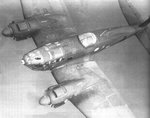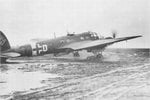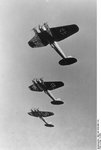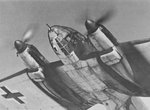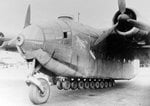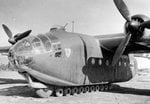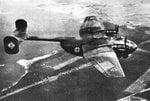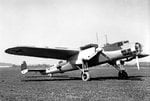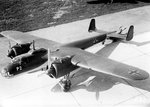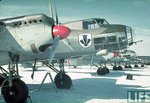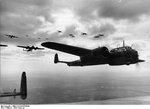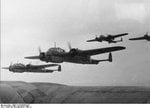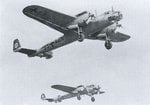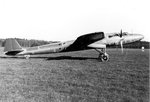Luftwaffe is a generic German term for an air force. It is also the official name for two of the four historic German air forces, the Wehrmacht air arm founded in 1935 and disbanded in 1946; and the current Bundeswehr air arm founded in 1956. Since the Treaty of Versailles forbade Germany from having an air force, German pilots had to be trained in secret from the Treaty of Versailles. Initially, civil aviation schools within Germany were used, yet only light training planes could be used in order to maintain the facade that the trainees were going to fly with civil airlines such as Lufthansa. To train its pilots on the latest combat aircraft, Germany solicited the help of its future enemy, the USSR, which was also isolated in Europe. A secret training airfield was established at Lipetsk in 1924 and operated for approximately nine years using mostly Dutch and Russian, but also some German, training aircraft before being closed in 1933. This base was officially known as 4th squadron of the 40th wing of the Red Army.
On 26 February 1935, Adolf Hitler ordered Hermann Göring to establish the Luftwaffe, breaking the Treaty of Versailles's ban on German military aviation. Germany violated the treaty without sanction from Britain, France, or the League of Nations, and neither they nor the league did anything to oppose this. Although the new air force was to be run totally separately from the army, it retained the tradition of according army ranks for its officers and airmen, a tradition retained today by united Germany's Luftwaffe and by many air forces throughout the world. It is worth noting, however, that before the official promulgation of Göring's new Luftwaffe in 1935, Germany had a paramilitary air force known as the Deutscher Luftsportverband (DLV: German air sports union). The DLV was headed by Ernst Udet and its insignia were taken over by the new Luftwaffe, although the DLV "ranks" had special names that made them sound more civilian than military. Dr. Fritz Todt, the engineer who founded the forced labor Organisation Todt, was appointed to the rank of Generalmajor in the Luftwaffe. He was not, strictly speaking, an airman, although he had served in an observation squadron during World War I and had been awarded the Iron Cross. He died in a plane crash in February 1942.
National Socialist Party came to power, the eagle held between his claws the symbol of the party—the swastika (an old symbol of sunrise)—which was usually enveloped by an oak wreath. Göring rejected the old heraldic eagle because he felt it was too stylized, too static, and too massive; instead he chose a younger, more natural and lighter eagle with wings spread as if in flight, as he considered this a more suitable symbol for an air force. While the Wehrmacht eagle held the symbol of the National Socialist Party firmly in its claws, the Luftwaffe eagle held the swastika with only one claw while the other was bent in a threatening gesture.
The Luftwaffe attempted to incorporate all military units that had anything to do with air warfare. Given the strong nazi origin and influence in the Luftwaffe, this was seen as a way to increase nazi influence in the army (alongside the other project in this respect, the formation of SS divisions), as well as boosting the personal prestige of Göring. Thus the anti-aircraft (Flak) and airborne troops (Fallschirmjäger) fell under direct Luftwaffe command, and the navy (Kriegsmarine) never established its own air branch; naval aviation was executed by the Luftwaffe. Even the aircraft flown from the (never finished) aircraft carrier Graf Zeppelin were intended to be operated by the Luftwaffe. By the middle of the war, when personnel assignments for the Luftwaffe were disproportionate to a shrinking amount of planes, the excess personnel was not transferred to the army (Heer), but instead organized into Luftwaffe Field Divisions in 1942. However, their performance as ground units was so poor that command was transferred to Heer in 1943, although they retained their name.
At the outset of the war, the Luftwaffe was one of the most modern, powerful, and experienced air forces in the world, dominating the skies over Europe with aircraft much more advanced than their foreign counterparts. The Luftwaffe was central to the German Blitzkrieg (lightning war) doctrine, as the close air support provided by various medium two-engine bombers, Stuka dive bombers and an overwhelming force of tactical fighters were key to several early successes. However, unlike the British and American Air Forces, the Luftwaffe never developed four-engine bombers in any significant numbers, and was thus unable to conduct an effective long-range strategic bombing campaign against either the Russians or the Western Allies.
The Messerschmitt Bf 109 was the most versatile and widely-produced fighter aircraft operated by the Luftwaffe and was designed when biplanes were still standard. Many versions of this aircraft were made. The engine, a liquid cooled Mercedes-Benz DB 601, initially generated up to almost 1,000 hp (750 kW). This power increased as direct fuel injection was introduced to the engines. The kill ratio (almost 9:1) made clear this plane was far superior than any of the other German fighters during the war. In this regard it was followed by the Focke-Wulf Fw 190 at 4:1. This plane had relatively short wings and was powered by a radial BMW engine. The Junkers Ju 87 Stuka was a main asset for Blitzkrieg, able to place bombs with deadly accuracy. The leader of the Luftwaffe was Hermann Göring, a World War I fighter ace and former commander of Manfred von Richthofen's famous JG 1 (aka "The Flying Circus") who had joined the Nazi party in its early stages.
In the second half of 1940, the Luftwaffe lost the Battle of Britain over the skies of England, the first all-air battle. Following the military failures on the Eastern Front, from 1942 onwards, the Luftwaffe went into a steady, gradual decline that saw it outnumbered and overwhelmed by the sheer number of Allied aircraft being deployed against it. Towards the end of the war, the Luftwaffe was no longer a major factor, and despite fielding advanced aircraft like the Messerschmitt Me 262, Heinkel He 162, Arado Ar 234, and Me 163 it was crippled by fuel shortages and a lack of trained pilots. There was also very little time to develop the new aircraft, and they could not be produced fast enough by the Germans, so the jet- and rocket-powered planes proved to be "too little too late".
On 26 February 1935, Adolf Hitler ordered Hermann Göring to establish the Luftwaffe, breaking the Treaty of Versailles's ban on German military aviation. Germany violated the treaty without sanction from Britain, France, or the League of Nations, and neither they nor the league did anything to oppose this. Although the new air force was to be run totally separately from the army, it retained the tradition of according army ranks for its officers and airmen, a tradition retained today by united Germany's Luftwaffe and by many air forces throughout the world. It is worth noting, however, that before the official promulgation of Göring's new Luftwaffe in 1935, Germany had a paramilitary air force known as the Deutscher Luftsportverband (DLV: German air sports union). The DLV was headed by Ernst Udet and its insignia were taken over by the new Luftwaffe, although the DLV "ranks" had special names that made them sound more civilian than military. Dr. Fritz Todt, the engineer who founded the forced labor Organisation Todt, was appointed to the rank of Generalmajor in the Luftwaffe. He was not, strictly speaking, an airman, although he had served in an observation squadron during World War I and had been awarded the Iron Cross. He died in a plane crash in February 1942.
National Socialist Party came to power, the eagle held between his claws the symbol of the party—the swastika (an old symbol of sunrise)—which was usually enveloped by an oak wreath. Göring rejected the old heraldic eagle because he felt it was too stylized, too static, and too massive; instead he chose a younger, more natural and lighter eagle with wings spread as if in flight, as he considered this a more suitable symbol for an air force. While the Wehrmacht eagle held the symbol of the National Socialist Party firmly in its claws, the Luftwaffe eagle held the swastika with only one claw while the other was bent in a threatening gesture.
The Luftwaffe attempted to incorporate all military units that had anything to do with air warfare. Given the strong nazi origin and influence in the Luftwaffe, this was seen as a way to increase nazi influence in the army (alongside the other project in this respect, the formation of SS divisions), as well as boosting the personal prestige of Göring. Thus the anti-aircraft (Flak) and airborne troops (Fallschirmjäger) fell under direct Luftwaffe command, and the navy (Kriegsmarine) never established its own air branch; naval aviation was executed by the Luftwaffe. Even the aircraft flown from the (never finished) aircraft carrier Graf Zeppelin were intended to be operated by the Luftwaffe. By the middle of the war, when personnel assignments for the Luftwaffe were disproportionate to a shrinking amount of planes, the excess personnel was not transferred to the army (Heer), but instead organized into Luftwaffe Field Divisions in 1942. However, their performance as ground units was so poor that command was transferred to Heer in 1943, although they retained their name.
At the outset of the war, the Luftwaffe was one of the most modern, powerful, and experienced air forces in the world, dominating the skies over Europe with aircraft much more advanced than their foreign counterparts. The Luftwaffe was central to the German Blitzkrieg (lightning war) doctrine, as the close air support provided by various medium two-engine bombers, Stuka dive bombers and an overwhelming force of tactical fighters were key to several early successes. However, unlike the British and American Air Forces, the Luftwaffe never developed four-engine bombers in any significant numbers, and was thus unable to conduct an effective long-range strategic bombing campaign against either the Russians or the Western Allies.
The Messerschmitt Bf 109 was the most versatile and widely-produced fighter aircraft operated by the Luftwaffe and was designed when biplanes were still standard. Many versions of this aircraft were made. The engine, a liquid cooled Mercedes-Benz DB 601, initially generated up to almost 1,000 hp (750 kW). This power increased as direct fuel injection was introduced to the engines. The kill ratio (almost 9:1) made clear this plane was far superior than any of the other German fighters during the war. In this regard it was followed by the Focke-Wulf Fw 190 at 4:1. This plane had relatively short wings and was powered by a radial BMW engine. The Junkers Ju 87 Stuka was a main asset for Blitzkrieg, able to place bombs with deadly accuracy. The leader of the Luftwaffe was Hermann Göring, a World War I fighter ace and former commander of Manfred von Richthofen's famous JG 1 (aka "The Flying Circus") who had joined the Nazi party in its early stages.
In the second half of 1940, the Luftwaffe lost the Battle of Britain over the skies of England, the first all-air battle. Following the military failures on the Eastern Front, from 1942 onwards, the Luftwaffe went into a steady, gradual decline that saw it outnumbered and overwhelmed by the sheer number of Allied aircraft being deployed against it. Towards the end of the war, the Luftwaffe was no longer a major factor, and despite fielding advanced aircraft like the Messerschmitt Me 262, Heinkel He 162, Arado Ar 234, and Me 163 it was crippled by fuel shortages and a lack of trained pilots. There was also very little time to develop the new aircraft, and they could not be produced fast enough by the Germans, so the jet- and rocket-powered planes proved to be "too little too late".

